5 Team Communication Plan Examples
The Team Communication Plan is an essential resource for anyone looking to enhance team collaboration and efficiency. This guide delves into various Communication Examples utilized in successful teams, offering practical insights and real-world applications. It addresses the core elements of effective team communication, from establishing clear objectives to overcoming common challenges. With a focus on actionable strategies and illustrative examples, this guide is tailored for leaders and team members eager to foster a more cohesive and productive work environment.
Download Team Communication Plan Bundle
Team Communication Plan
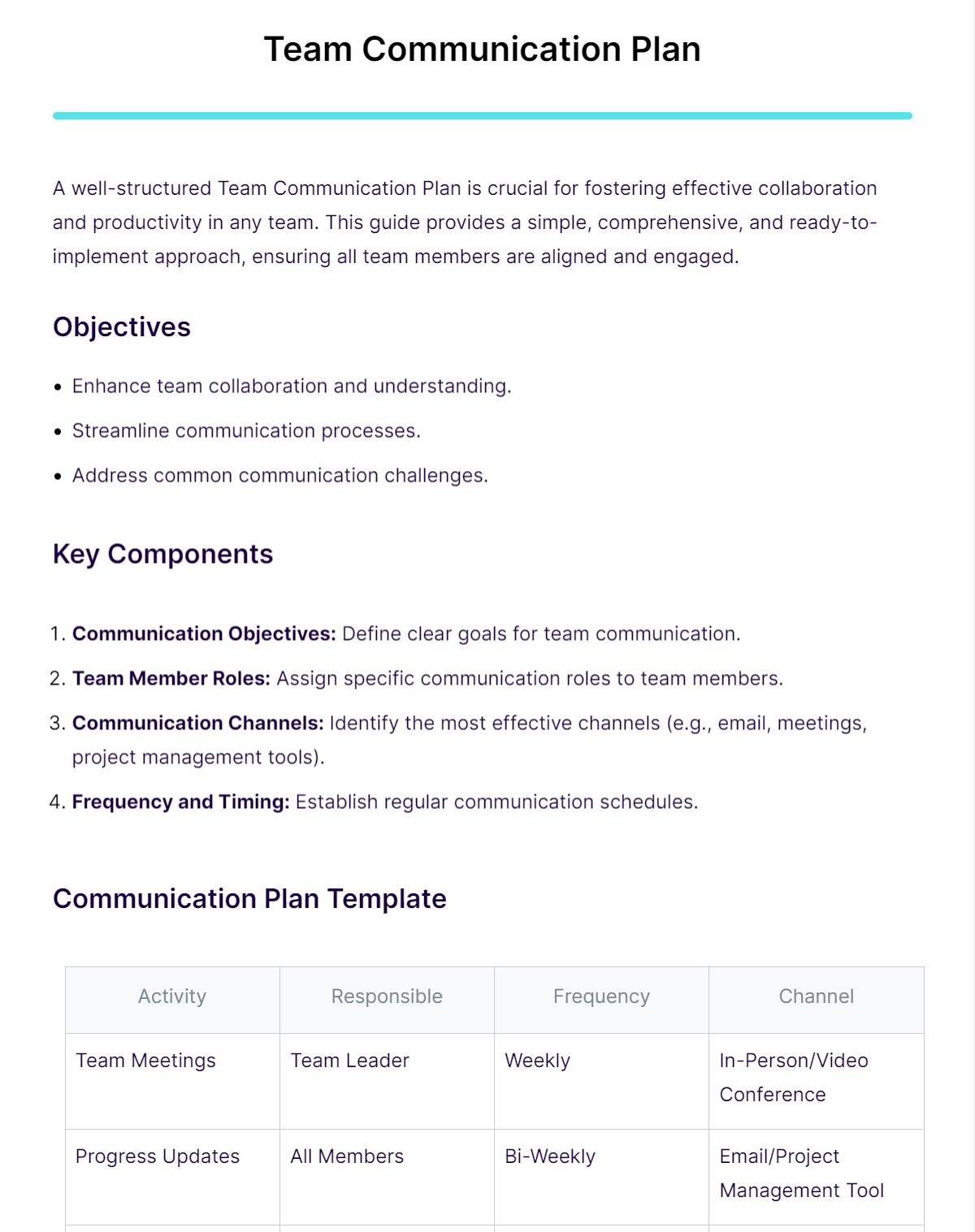
The Team Communication Plan comprehensive guide for creating effective team communication strategies. It highlights key components such as setting clear communication objectives, assigning specific roles to team members, and choosing the most effective channels for communication. The guide also provides a practical template for organizing team meetings, progress updates, and feedback sessions. Additionally, it emphasizes best practices like open and honest communication, active listening, and conflict resolution. This resource is ideal for teams seeking to improve their communication effectiveness and overall productivity
Project Team Communication Plan
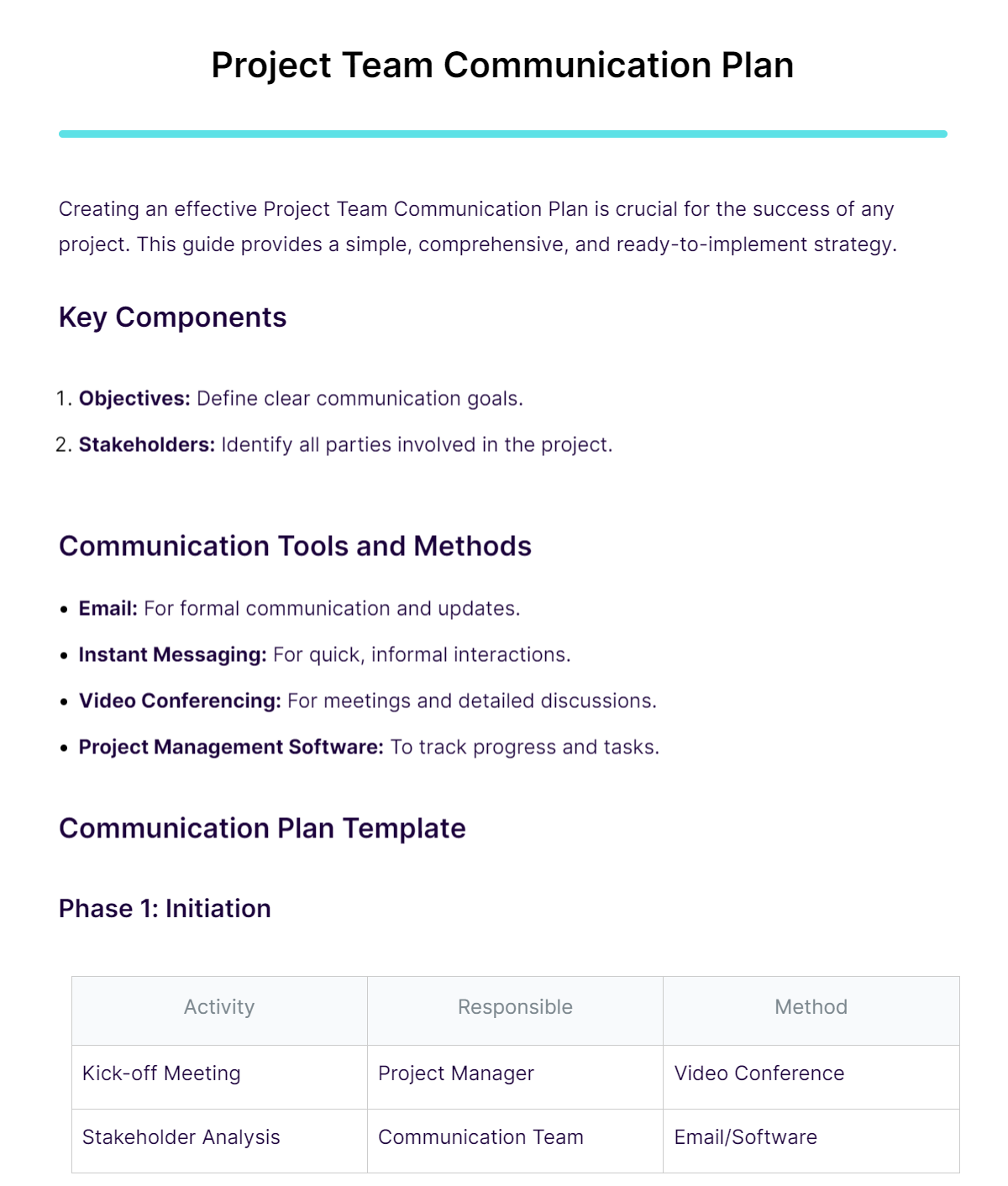
The Project Team Communication Plan. It outlines the key components, tools, and methods crucial for effective communication in a project team, including objectives setting, stakeholder identification, and utilization of various communication tools like email, instant messaging, and project management software. The guide includes a template covering the initiation, planning, execution, and closure phases of communication in a project, along with best practices like regular updates, clear documentation, and feedback mechanisms. This comprehensive guide is designed to enhance team collaboration and lead to successful project completion
Internal Team Communication Plan
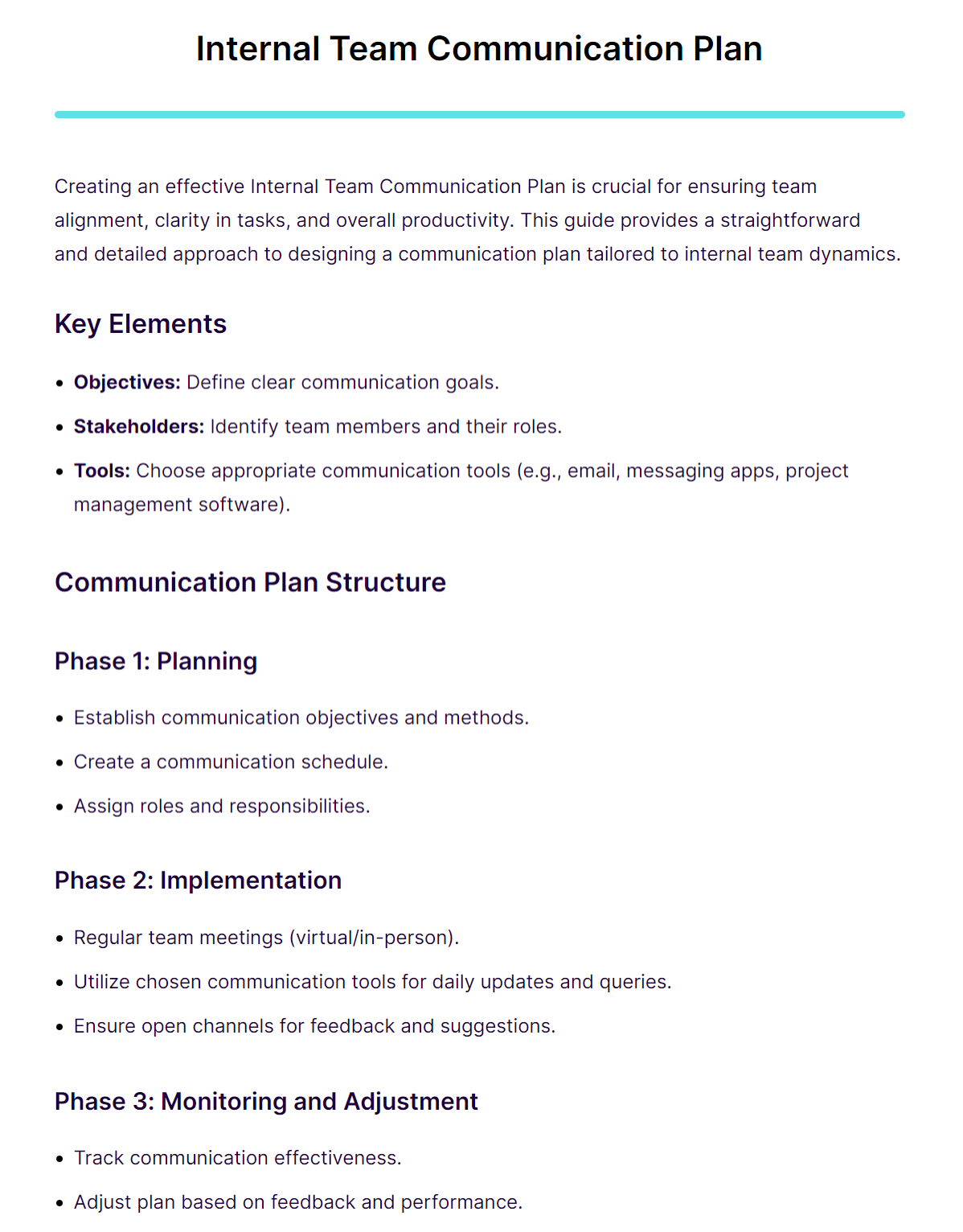
The Internal Team Communication Plan. It emphasizes the importance of defining clear communication goals, identifying team member roles, and selecting appropriate communication tools. The guide outlines a structured approach including planning, implementation, and monitoring phases, incorporating best practices like open communication, regular reviews, and fostering a respectful culture. This resource is beneficial for teams aiming to improve their internal communication efficiency and productivity.
Team Communication Plan Example
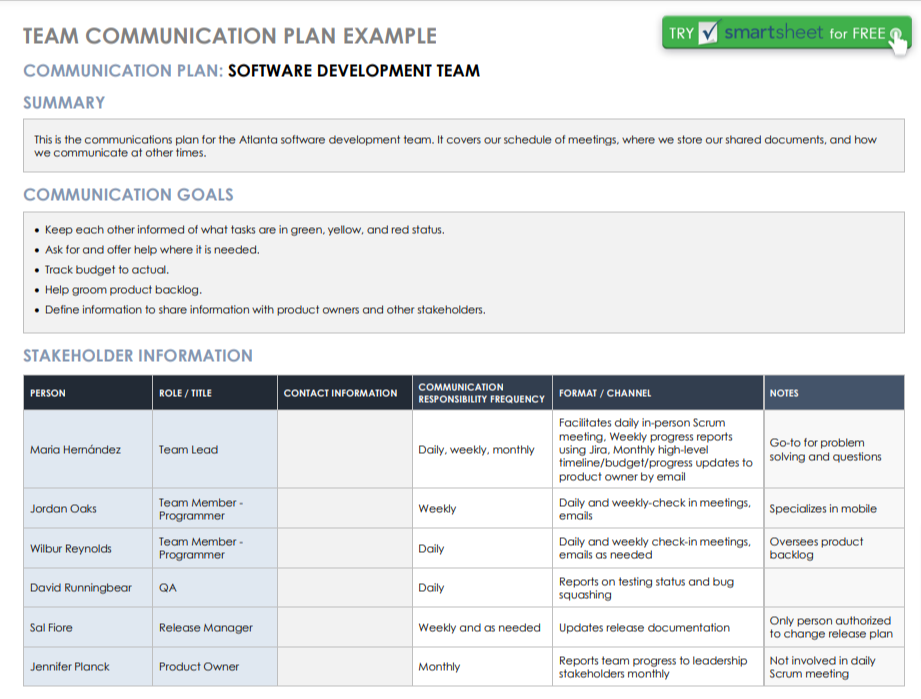
smartsheet.com
DownloadTeam Charter Communication Plan
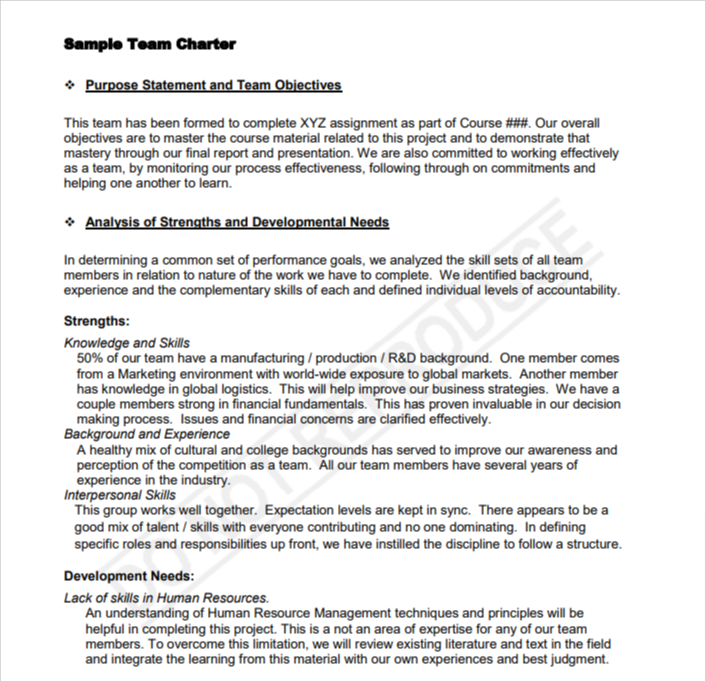
teamhelper.com
DownloadSteps to Writing an Effective Team Communication Plan
Creating an effective Team Communication Plan involves clear steps that promote efficient and cohesive team collaboration. This process ensures that all team members are on the same page, fostering a productive work environment.
- Identify Team Objectives: Clearly define the goals your team aims to achieve.
Example: “Our main objective is to improve client satisfaction by 20% this quarter.” - Determine Communication Channels: Choose the most appropriate channels for different types of communication.
Example: “For project updates, we’ll use our project management tool, but for urgent matters, let’s stick to instant messaging.” - Establish Communication Frequency: Decide how often the team should communicate. Example: “We’ll have weekly team meetings every Monday to discuss progress and challenges.”
- Assign Roles and Responsibilities: Clearly define who is responsible for various communication tasks.
Example: “Anna will be responsible for sending out the weekly newsletter to the team.” - Create a Feedback Mechanism: Implement a system for team members to give and receive feedback.
Example: “Please use the feedback form on our intranet to share your thoughts about the new communication process.” - Develop a Crisis Communication Plan: Prepare for potential communication challenges and crises.
Example: “In case of a system outage, immediately inform the team via our emergency SMS chain.” - Incorporate Team Building Activities: Include activities that strengthen team dynamics and communication.
Example: “Let’s have a monthly virtual coffee catch-up to connect on a personal level.” - Monitor and Adjust the Plan: Regularly review the effectiveness of the communication plan. Example: “Next month, we’ll reassess our communication strategies to see if they meet our team’s needs.”
- Encourage Open Dialogue: Create an environment where team members feel comfortable sharing ideas and concerns.
Example: “I encourage everyone to openly share their ideas during our brainstorming sessions.” - Document and Share the Plan: Ensure that the communication plan is documented and accessible to all team members.
Example: “The finalized communication plan will be shared on our team portal for everyone to access.”
Strategies and Tips for Improving Team Communication Plan
Improving a Team Communication Plan involves strategic planning and the implementation of effective techniques. Here are some strategies and tips to enhance team communication:
- Regular Reviews and Feedback: Encourage team members to provide feedback on the communication plan. Regularly review and update the plan to address any issues or changes in team dynamics.
- Utilize Technology Efficiently: Leverage technology like project management tools, instant messaging apps, and video conferencing to streamline communication. Choose tools that best fit the team’s needs.
- Set Clear Expectations: Clearly define communication protocols, including response times, appropriate channels for different types of messages, and meeting schedules.
- Encourage Active Listening: Promote a culture where team members actively listen to each other, acknowledging and responding thoughtfully to inputs.
- Foster Open and Transparent Communication: Create an environment where team members feel comfortable sharing their ideas, concerns, and feedback without fear of judgment.
- Training and Development: Offer training sessions on effective communication skills and conflict resolution to enhance team members’ capabilities.
- Recognize and Celebrate Successes: Acknowledge and celebrate when effective communication leads to successful outcomes.
- Tailor Communication to Individual Needs: Understand that team members have different communication preferences and adapt accordingly.
- Focus on Non-Verbal Communication: Pay attention to non-verbal communication cues in communication, especially in remote settings, to ensure messages are conveyed and understood correctly.
- Build a Culture of Trust: Develop a team culture where trust is paramount, ensuring that communication is honest and respectful.
How to Create a Communications Plan for Your Team?
Creating a communications plan for your team is crucial in ensuring effective and streamlined interactions. Here are the key steps to consider:
- Assess Communication Needs: Evaluate the current communication processes and identify areas for improvement. Understand the unique communication requirements of your team.
- Define Objectives: Set clear, measurable goals for your communication plan. These might include enhancing team collaboration, ensuring timely information sharing, or improving project management efficiency.
- Identify Stakeholders: Determine who will be involved in the communication process. This includes team members, management, and any other relevant parties.
- Choose Communication Tools and Channels: Select the most appropriate tools and channels for your team. This could range from emails and messaging apps to project management software and video conferencing tools.
- Establish Protocols: Develop guidelines for how and when different types of communication should occur. This might involve setting specific times for meetings, guidelines for email communication, or norms for instant messaging.
- Implement a Feedback System: Incorporate a mechanism for receiving and integrating feedback on the communication process. This could be through regular surveys, suggestion boxes, or open forums.
- Monitor and Revise: Continuously assess the effectiveness of the communication plan. Be prepared to make adjustments as needed based on team feedback and changing circumstances.
- Documentation and Accessibility: Ensure the communication plan is well-documented and easily accessible to all team members.
- Training and Support: Provide necessary training and support to team members to use the chosen communication tools effectively.
- Review and Update Regularly: Regularly review the communication plan to ensure it remains relevant and effective in meeting the team’s needs
How to Ensure Communication and Collaboration With Your Team?
Ensuring effective communication and collaboration within a team is pivotal in a “Team Communication Plan.” This involves several key steps:
- Establish Clear Communication Channels: Determine the most effective tools and platforms for team communication. This could include email, instant messaging, or project management software.
- Regular Meetings and Check-Ins: Schedule regular team meetings and individual check-ins to discuss progress, address issues, and share updates. These can be a mix of formal and informal interactions.
- Define Roles and Responsibilities: Clearly outline each team member’s roles and responsibilities. This clarity prevents overlap and ensures accountability.
- Encourage Open and Honest Feedback: Create an environment where team members feel comfortable sharing their thoughts and feedback. This could be through anonymous surveys or open forum discussions.
- Utilize Collaborative Tools: Implement collaborative tools like shared documents, whiteboards, or brainstorming sessions that promote teamwork and idea sharing.
- Training and Development: Provide training sessions on effective communication skills and team collaboration techniques.
- Monitor and Adapt: Regularly assess the effectiveness of communication strategies and be ready to make adjustments as needed.
- Celebrate Successes: Acknowledge and celebrate team achievements, which can boost morale and encourage further collaboration.
What Should a Team Communication Plan Include?
A comprehensive Team Communication Plan should encompass several key elements to optimize team interaction and productivity. These elements include:
- Objectives and Goals: Clearly define what the team intends to achieve through its communications.
- Team Member Roles and Responsibilities: Detail who is responsible for various communication tasks.
- Communication Channels: Identify the tools and platforms used for communication, such as emails, instant messaging, or project management software.
- Frequency and Types of Communication: Establish how often the team will communicate and in what format, including meetings, reports, and informal updates.
- Feedback Mechanisms: Implement ways for team members to provide and receive feedback effectively.
- Crisis Communication Protocols: Outline procedures for communication in emergency or unexpected situations.
- Review and Adaptation Processes: Set regular intervals to assess the effectiveness of the communication plan and make necessary adjustments.
- Documentation and Accessibility: Ensure the communication plan is documented and easily accessible to all team members.
- Inclusion of Team Building Activities: Incorporate activities that foster better understanding and collaboration among team members.
- Monitoring and Evaluation Methods: Include strategies for monitoring the communication flow and evaluating its impact on team performance.
The qualitative analysis of what constitutes effective team communication, specifically in interprofessional primary care teams. It highlights elements like shared knowledge, situation awareness, problem-solving, mutual respect, and transparency. Additionally, it emphasizes the importance of communication being timely, frequent, consistent, and parsimonious, especially in structured clinic settings. This research offers valuable insights for teams looking to enhance their communication strategies in similar environments.
The guide from UC Berkeley outlines essential steps for effective team communication. It emphasizes the importance of establishing leadership, considering each team member’s ideas, and being aware of their feelings. The guide also highlights the need for clear communication, encouraging trust and cooperation, and facilitating team problem-solving. It stresses the significance of setting team values and goals, using consensus for decision-making, and establishing team norms. For a more in-depth understanding of these steps and their impact on team building.



